Maces
About Andrew Cusack
 Writer, web designer, etc.; born in New York; educated in Argentina, Scotland, and South Africa; now based in London.
Writer, web designer, etc.; born in New York; educated in Argentina, Scotland, and South Africa; now based in London. read more
News
Blogs
Reviews & Periodicals
Arts & Design
World
France
Mitteleuropa
Knickerbockers
Argentina
The Levant
Africa
Cape of Good Hope
Netherlands
Scandinavia
Québec
India
Muscovy
Germany
Academica
Papal Mace for St Andrews
Archbishop Presents New Mace to Scotland’s Oldest University Amidst 600th Anniversary
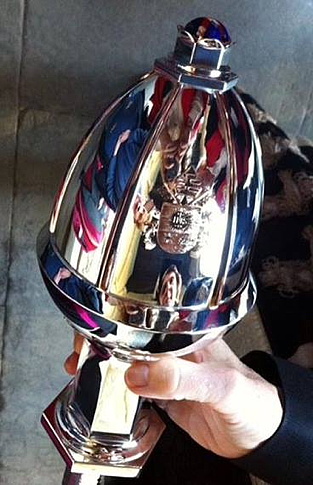
Above: The 600th Anniversary Mace.
Below: The University’s three medieval maces:
St Salvator’s College, 1461; Faculty of Canon Law, circa 1450; Faculty of Arts, 1416.
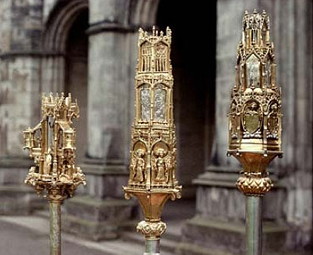
ST ANDREWS University already boasts the world’s finest collection of medieval maces, but a new ceremonial mace was added to the university’s hoard recently. In honour of the University’s six-hundredth anniversary, the Most Rev Leo Cushley, Archbishop of St Andrews & Edinburgh, has presented the institution with a new ceremonial mace on behalf of the Catholic Church.
“This completes a triple recognition of the University St Andrews,” said Dr John Haldane, the University’s professor of philosophy.
“During his visit to Scotland at the outset of this decade, Pope Benedict referred to the university beginning to mark the 600th anniversary of its foundation, then last year Pope Francis sent a message of congratulation, and now his office has granted permission for the inclusion of his coat of arms on the head of a mace commissioned to mark the completion of several centuries and the beginning of who knows how many more.”
The silver mace with gold rose details was crafted by Hamilton & Inches of Edinburgh, who also constructed the mace of the Faculty of Medicine at St Andrews over a half-century ago. Their master silversmith Jon Hunt designed the mace, in consultation with Prof Haldane.
The mace’s head is reminiscent of Brunelleschi’s dome of Florence Cathedral, recalling St Andrews’s links with the Continent which were foremost in the University’s first century and a half while it was a Catholic institution. Atop the head a saltire design is incorporated, referencing the apostle who gave his name to both the Royal Burgh and the University as well as the country who’s first university St Andrews is.
Heraldic shields display the arms of the University and of Pope Francis who invoked “upon all the staff and students of the University, past and present, the abundant blessings of Almighty God, as a pledge of heavenly peace and joy”. (more…)
The Parliament of the Venerable Island
Geoffrey Bawa’s Sri Lankan Parliament at Kotte
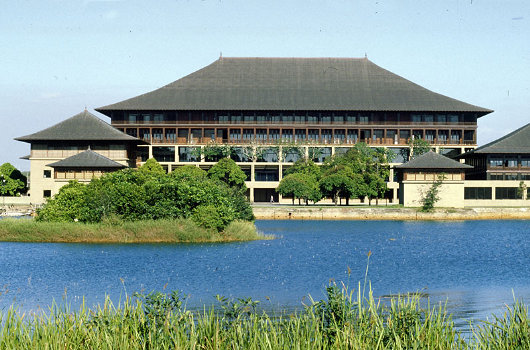
CEYLON IS AN ancient island whose history spans the epochs of human existence: palaeontologists estimate it has been inhabited for over 34,000 years. A series of ancient and medieval native kingdoms have ruled this island over the centuries before foreigners from abroad decided to enter the game. The Portuguese were the first Europeans to stake a claim here, followed by the Dutch Republic. And, yes, as with almost every place of intrigue and tradition, even Ceylon belonged to the Hapsburgs at one point: from 1580 to 1640. Native kingdoms persisted nonetheless, even while European powers bickered over their own portions of the island.
It was in 1815 that the Chiefs of the Kandyan Kingdom agreed to depose their own monarch, Sri Vikrama Rajasinha, and place George III of the House of Hanover on the throne. Ceylon was united at last, and — after the end of the Kandyan Wars — the island enjoyed relative peace and prosperity during one-hundred-and-thirty-three years of British rule.
In 1948, the British granted independence to the Dominion of Ceylon. The island continued as an independent constitutional monarchy for much longer than its neighbours India and Pakistan. The rudiments of a two-party system emerged, with the United National Party bringing together the conservative, traditional element in political society, while the Freedom Party advocated non-revolutionary socialism.
The population of Ceylon, however, are a complete hodgepodge of ethnicities. The largest group are the Sinhalese, a Buddhist people constituting over 70% of the population. But at the northern end of the island, the Tamil people were dominant, even though these were split between “Ceylonian” Tamils native to the island and “Indian” or “Plantation” Tamils brought during British rule to work the large plantations. Then there are the Moors, a multiracial Muslim community of primarily Arab and Malay descent. And, of course, there are the famous Burgher people, descendants of the island’s Portuguese, Dutch, and English mixed with Sinhalese, Tamil, and Creole.
Democratically elected politicans replaced English (the intercommunal lingua franca) with Sinhala (the language of the Sinhalese majority) as the official language, abolished the Senate, severed appeal to the Privy Council and, in 1970, abolished the monarchy. The Dominion of Ceylon was renamed the Republic of Sri Lanka — the name literally means “Venerable Island”. Left-wing nationalists continually stoked tensions with the country’s conservatives, traditional elite, and minorities, and provoked right-wing reactions. Aside from the left-right divide, Tamil extremists began an anti-Sinhalese terror campaign that increased the oppression of the Tamil people and strengthened the country’s divisions. In short, it all became a mess. (more…)
Old Dominion, New Mace
THE HOUSE OF DELEGATES OF THE COMMONWEALTH OF VIRGINIA
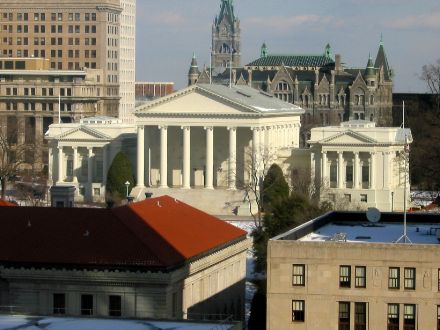
VIRGINIA IS THE birthplace of Anglo-America, and as such it has managed to maintain higher standards of propriety than most other places in the States, including its long-time rival, New England. Governors, for example, still wear morning dress for their inaugurations rather than the lamentable business suit which has usurped events even so high and mighty as the inauguration of the President of the United States. (Carter abolished morning dress for the inauguration, Reagan wore it  for his first with a stroller instead of tailcoat, but since then it’s been suits all around). Roger Scruton, Britain’s greatest living Conservative thinker, recently moved with his family to Virginia to enjoy the fruits of American freedom since one of his favorite pasttimes, outlawed back in the Mother Country, thrives in his new home. The origin of Virginia’s traditional nickname, ‘the Old Dominion’, is from King Charles II who granted the Colony that title of Dominion as a recognition of its steadfast loyalty to the Crown during the trying days of the Interregnum.
for his first with a stroller instead of tailcoat, but since then it’s been suits all around). Roger Scruton, Britain’s greatest living Conservative thinker, recently moved with his family to Virginia to enjoy the fruits of American freedom since one of his favorite pasttimes, outlawed back in the Mother Country, thrives in his new home. The origin of Virginia’s traditional nickname, ‘the Old Dominion’, is from King Charles II who granted the Colony that title of Dominion as a recognition of its steadfast loyalty to the Crown during the trying days of the Interregnum.
Some traditions, however, have been mournfully discontinued. Virginia’s House of Burgesses was the first legislative body in the New World but its name was changed to the House of Delegates during the Revolution. (North Carolina, meanwhile, kept its House of Commons until it was defeated by the United States in the Civil War). Nonetheless, the House sat in the antiphonal pattern akin to the British and Commonwealth parliaments until 1904 when it adopted the dastardly French republican semicircular seating plan. To my knowledge, it was the last American legislature (outside of Canada, of course) to arrange its seating in the traditional way. (more…)
The Mace of the Palmetto State
THE HOUSE OF REPRESENTATIVES OF SOUTH CAROLINA
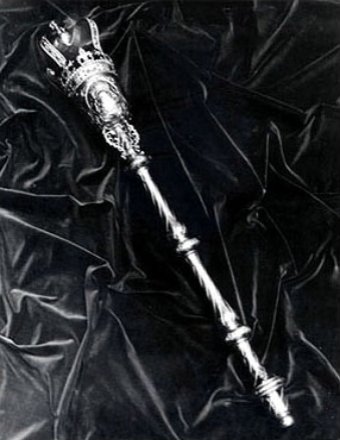
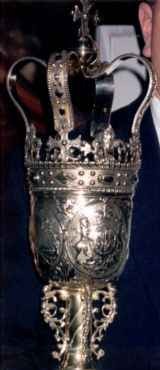 The mace currently used by the lower house of the General Assembly of South Carolina is another fine example of pre-revolutionary legislative regalia. It is a reminder of tradition in a state which takes great pride in its history and heritage. Furthermore, this ancient inheritance is still in everyday use. In 1880 the tradition of the Speaker’s procession was restored and since that year every legislative day has begun with the mace being borne by the Sergeant-at-Arms of the House, followed by the Speaker. When the Speaker reaches his chair in the House chamber, he exchanges bows with the Sergeant-at-Arms, who then places the mace upon its holster before the rostrum, exchanges bows with the Speaker once more, and thence the legislative day is called to commence. Whenever the House and Senate meet in joint session, the Mace is carried at the head of the procession.
The mace currently used by the lower house of the General Assembly of South Carolina is another fine example of pre-revolutionary legislative regalia. It is a reminder of tradition in a state which takes great pride in its history and heritage. Furthermore, this ancient inheritance is still in everyday use. In 1880 the tradition of the Speaker’s procession was restored and since that year every legislative day has begun with the mace being borne by the Sergeant-at-Arms of the House, followed by the Speaker. When the Speaker reaches his chair in the House chamber, he exchanges bows with the Sergeant-at-Arms, who then places the mace upon its holster before the rostrum, exchanges bows with the Speaker once more, and thence the legislative day is called to commence. Whenever the House and Senate meet in joint session, the Mace is carried at the head of the procession.
When the House is invited by the Senate to ratify passed legislation, the Sergeant-at-Arms bears the mace before the Speaker and the Clerk of the House in a solemn procession through the corridors of the State House, across the rotunda to the Senate chamber. There, it is put in a holding place just below the Sword of State, symbol of authority in the Senate and interesting in its own right, while the Speaker of the House, the President of the Senate, and the Clerks of both houses sign the acts. (more…)
A 250-Year-Old Mace in the Old Dominion
 THE MACE OF the City of Norfolk in the Commonwealth of Virginia is believed to be the oldest civic mace in any of the United States still in use by the city for which it was made. Robert Dinwiddie, the Lieutenant Governor and Commander-in-Chief of the Dominion of Virginia, commissioned the English silversmith Fuller White to make the silver and wood mace for the City of Norfolk, at the time the largest town in the crown colony. The inscription around the base of the bowl of the Mace denotes the generous donation:
THE MACE OF the City of Norfolk in the Commonwealth of Virginia is believed to be the oldest civic mace in any of the United States still in use by the city for which it was made. Robert Dinwiddie, the Lieutenant Governor and Commander-in-Chief of the Dominion of Virginia, commissioned the English silversmith Fuller White to make the silver and wood mace for the City of Norfolk, at the time the largest town in the crown colony. The inscription around the base of the bowl of the Mace denotes the generous donation:
Despite the inscription of 1753, the mace took some time to reach the shores of America, and the minutes of the Norfolk council record the actual presentation:
Fuller White built the mace of eleven interlocking pieces of sterling silver weighing 104 ounces, which centered around a wooden rod. The Norfolk mace measures forty-one-and-a-half inches long from the very bottom of the base to the apex of the crown.
The Royal Arms, depicted in three places on the mace, most prominently outside the bowl and inside the base of the crown, are those of George II, Britain’s second German king known for his poor grasp of the English language.
In several places on the mace are depicted national emblems of George’s realm: the English rose, the Scottish thistle, the Irish harp, and the fleur-de-lis representing the claim to the throne of France still maintained — at least heraldically — at the time. (more…)
The ‘New South’ Scorns an Old Mace
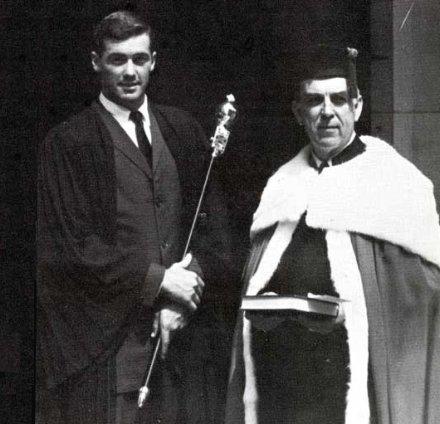
George Hart, President of the Order of Gownsmen, bears the University Mace for the Vice-Chancellor, Dr. McCrady
“The recent convocation at Sewanee’s All Saints’ Chapel was a majestic display,” writes the Atlanta Journal-Constitution. “University hierarchs in medieval garb spoke Latin, their words echoing throughout the nave. New honor students donned black robes, marking their entrance into the prestigious Order of Gownsmen. Everyone sang: “Alma Mater, Sewanee, My glorious Mother ever be. (more…)
The University Maces
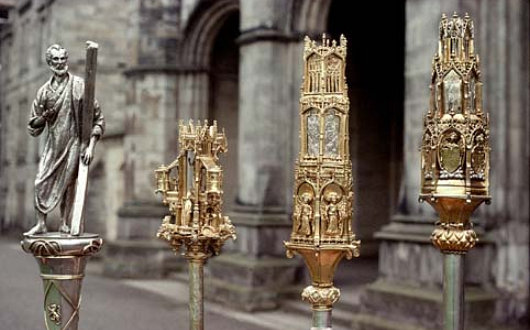
On my last day in St Andrews before summer break, Michelle Romero and I were lucky enough to finagle our way into a private showing of the University’s maces to the Kate Kennedy Club, organized by the Head Janitor & Bedellus, Jim Douglas, M.A. It was amazing. The metalwork on these maces (six in total) is so intricate and beautiful.
The late R.G. Cant said that if he had to put a value to the maces, Bishop Kennedy’s mace (made in 1461 in Paris) would be worth £10 million, and the mace of the Faculty of Arts would be £5 million, though in effect they are priceless. I have to admit it was nearly frightening to hold £10 million pounds in your hands.
It’s such a shame that the modern mace for the whole of the University (furtherst left in the photo) pales in comparison to the others, especially since it is the mace used at Chapel and thus the mace used most often. Mr. Douglas told us that the rod of the Rector’s mace (not pictured) is actually a broomstick painted black. Apparently, the Principal and Vice-Chancellor, Dr. Brian Lang, is going to have it replaced with a lengthened ebony rod.
Search
Instagram: @andcusack
Click here for my Instagram photos.Most Recent Posts
- Sag Harbor Cinema March 26, 2025
- Teutonic Takeover March 10, 2025
- Katalin Bánffy-Jelen, R.I.P. March 3, 2025
- Substack Cusackiensis March 3, 2025
- In the Courts of the Lord February 13, 2025
Most Recent Comments
Book Wishlist
Monthly Archives
Categories


